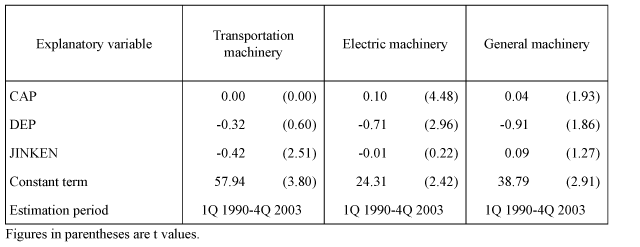Appended Note 3-2 Impacts of Exchange Rates on Exporting Companies' Profits
- Japanese
- English
Based on Oyama (1998), the level at which exchange rates impact corporate profits is estimated using the following formula. Fluctuations in the impact level of exchange rates on corporate profits are measured by implementing the Kalman filter, whereby, the exchange rate coefficient is the variable parameter. For estimates obtained from the Kalman filter, the random walk model is used to analyze patterns of change observed in the parameter.

The percentage of gross profits on sales and the ratio of personnel costs to sales volume are obtained from quarterly data (Q1 1990-Q4 2003) in the Ministry of Finance's Statistics of Corporations by Industry on corporations with over one billion yen in capital. The capital utilization index and the nominal effective exchange rate are obtained from the Ministry of Economy, Trade and Industry and Bank of Japan websites respectively.
Estimation results
The parameter for the nominal effective rate is the profit elasticity that appears in the top three graphs of Figure 3-2-10. This parameter represents trends in the level of impact that exchange rates had on the sales-profit ratio. Results show that during the 1990s, the impact level significantly declined for transportation machinery, moderately declined for electric machinery and moderately increased for general machinery.
Coefficients and t values for the other explanatory variables are as follows.

